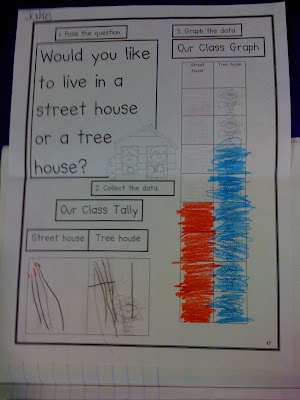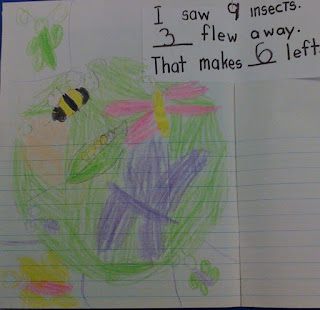In Kindergarten the children are learning to understand that addition is putting together parts and that subtraction is taking apart using concrete objects. As the year draws to a close and we begin to clean the classroom and put away math stations I have planned for students to review counting, addition and subtraction. Debbie Diller of Math Work Stations points out that it is this kind of work which embeds basic facts and bigger numbers into meaningful tasks that children enjoy and can connect with. Most of these activities have practice with subitizing as well (subitize means to instantly recognize a number group such on a domino). Here is a link if you would like a little more information on subitizinghttp://michellef.essdack.org/node/126
It is during these busy times that I especially appreciate my kindergarten and grade one fellow bloggers. Usually I would begin by going through last year's planning folder, my math professional books and online searches but this year WOW it has been much easier, I just visited my favourite sites and look for counting, addition and subtraction activities that I have the resources for. Here are some of the math activities that we will be doing over the final few weeks. I usually ask them to write their math sentences on a dry erase board instead of paper and pencil.
Junk boxes: fill small dollar story plastic sandwich boxes with small assorted objects and number cards. Working with a partner the children sort the objects into groupings according to the card. Alternatively you could offer an open ended activity and challenge students to sort into groups so that no objects are left. How many groups could they make, how many different combinations, ... This activity is from Math Their Way and is used throughout the year for free exploration, graphing, counting, patterning, sorting and simple math problems. http://www.center.edu/index.shtml
Counting Mats:
Using a grid paper and a number (for example nine) the student makes a counting mat using small stickers or stamps to repeat the same number in each box. Cotton Ball Counting: http://www.childcareland.com/teach4.html
You can download the worksheet at this site. The child scoops cotton balls and then counts them. Then the child counts out a glue dot onto the worksheet and then matches a cotton ball with each dot (tweezers make it much more fun!). The student prints the number in the number box.
Counting tasks: http://www.hubbardscupboard.org/math_tubs.html
has many simple math counting activities using buttons, shells, pennies, etc and simple icons such as pigs, shirts, ropes. Children use dot cards, dice or a spinner to sort objects into groups and put then onto picture cards.
Block Stacking: http://www.childcareland.com/teach5.html
This year I am building up a collection of 3D table blocks. Another type of block that has been great that I purchased last year are magnitic foam Edushapes. They create castles, houses, cities, and come with idea cards which I laminated... Lots of fun!
Monster Addition: This activity comes from http://mrsbremersk.blogspot.ca/search/label/counting%20activities
Students each take a monster math mat (I put them into plastic sleeves). They take turns rolling two die (I use a double dice) and then figure out the sum. They count out that number of goggle eyes and put them on their monster. I have a smaller monster mat (from childcareland.com) that I use in the fall for just counting out with dot cards and large googlyeyes for a math station.
Subtraction Game: ten frame grid sheet, small counters
Students place a counter on each square. The student rolls a die or uses a dot card and removes that number of counts from their ten frame. The student keeps playing until all counters are removed.
Whole-part-part relationship: D. Diller, Math Work Stations, 113.
Here is a great site for math blackline masters
http://lrt.ednet.ns.ca/PD/BLM/table_of_contents.htm
Provide an oversize ten frame (I have large blank, Power of Ten cards which have a plastic coating), small objects and a numeral cube. Children begin by placing an object in each space on the ten frame and saying "I have 10. They roll the numeral cube which tells how many they get to keep. If they roll a 5 they say "I get to keep 5." Then they figure out how many they'd have to take out to have five remain. They say "How many do I take out" and remove five objects. They count to see that they have five left. Finally they write the math fact and say ten take away five equals five. The game begins again with ten objects.
Race to 20: Number line grid with numbers to 20.
Students roll a die, use a dot card or spinner and move up the grid or for subtraction move down the grid. Another version of this game is using addition and subtraction at the same time with coloured dots on cards. If they turn over a card with red dots they move up the grid but if it has black dots they move down.
Story Problems: This an independent journal activity
at this time of year. The Kinders are given a story problem to solve by drawing
a picture.
I find with subtraction problems that using a circle to help seperate the two number groups makes it more concrete for the Kinders.
Addition Towers or Subtraction Race:
Children work either with a partner or alone. In this example the Kinders built trains of equal length with unifix cubes. Then they turned over a card and broke off the number of cubes from their train shown on the card and did the math talk "four + six." A second way to play this game is for the student or partners to decide upon a number and build that tower. Then they turn over a card or roll dice and remove that number of cubes. The first child to get to zero determines the length of the train used for the next game (this idea comes from Math Their Way and they love it!). It is so easy to teach this game and lots of math talk happens.
The Hand Game: (tiny acquarium rocks, but you could use any tiny group of objects)
The partners decide upon a number together ie: 8. One child creates combinations and using both hands. The child opens one hand and shows the number (I have ... how many are in my other hand) the partner guesses and then the number is revealed. They write the number combinatins down ie: 3 + 5, 7 + 1, ... (source unknown). This is a really easy and popular game with my students. It allows partners the choice to begin with a number they feel confident with and move onto more challenging numbers. They decide on the beginning number together and then after a couple of games they increase the number by one and begin again.
Lift the Bowl: small animals or toys, white board, dry erase marker & eraser, small plastic bowl (similiar to the hand game)
Partners decided together on the "sum", then take turns hiding some of the objects under a bowl and a second child guesses the number combination. Together they record the combinations on a white board. (This game comes from Math Their Way but is found in lots of math guides)
Number Combos:
 Using a two colour mat students agree upon a challenge number such as ten. A student turns over a number card and moves that number of objects to the opposite side of the mat, creating a new number sentence. Then the student reads the new the number sentence 5 + 5 and continues to play as the objects move back and forth across the board. This is a perfect game for developing subitizing if you use dot cards beginning with numbers one to five.
Using a two colour mat students agree upon a challenge number such as ten. A student turns over a number card and moves that number of objects to the opposite side of the mat, creating a new number sentence. Then the student reads the new the number sentence 5 + 5 and continues to play as the objects move back and forth across the board. This is a perfect game for developing subitizing if you use dot cards beginning with numbers one to five.The math talk is very important in this game so make sure that you set high expectations (This idea came from Math Makes Sense but is found in lots of math guides).
Student Surveys:

This is independent work at this time of year. During open play time, the student walks around the room with a clipboard and worksheet, asking the survey question. With each answer the student makes a tally mark. After ten students have been surveyed the student transfers the data to a graph and then compares the data ie: there are five students who prefer apples and five students who prefer grapes.
We frequently do whole class surveys but this is just a great thinking, counting and comparing activity we do once weekly. Many of the math units from tpt have surveys but they are also simple to make. I keep a template and just switch the question, picture or the type of graph. Survey was a popular student choice for their math e-portfolios so it definitely is well liked.
We frequently do whole class surveys but this is just a great thinking, counting and comparing activity we do once weekly. Many of the math units from tpt have surveys but they are also simple to make. I keep a template and just switch the question, picture or the type of graph. Survey was a popular student choice for their math e-portfolios so it definitely is well liked.
We will be doing these activites for June. I will add photos as we go along.
I hope that you enjoy this little peak into our final days.





No comments
Post a Comment
Note: only a member of this blog may post a comment.